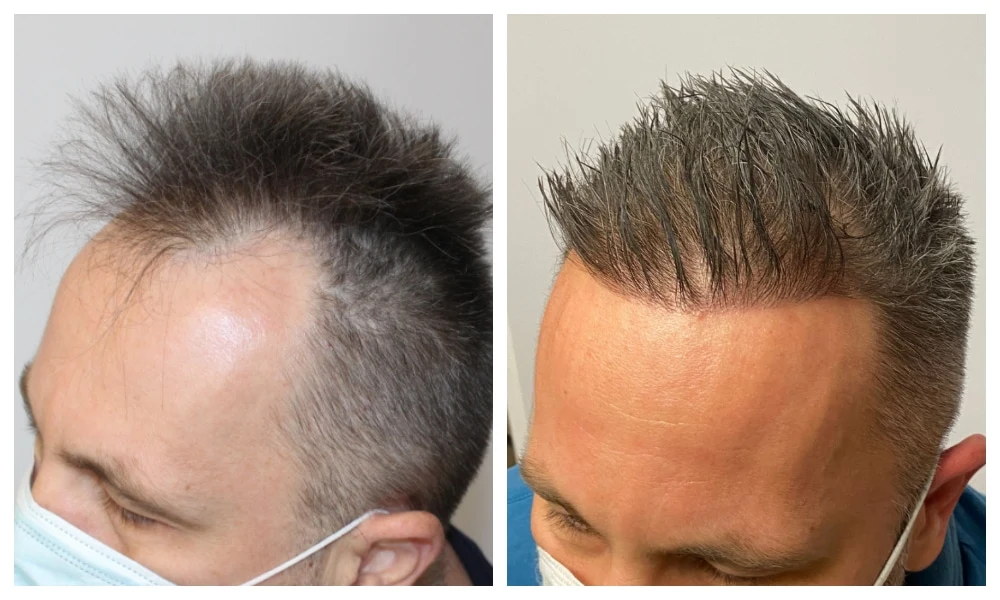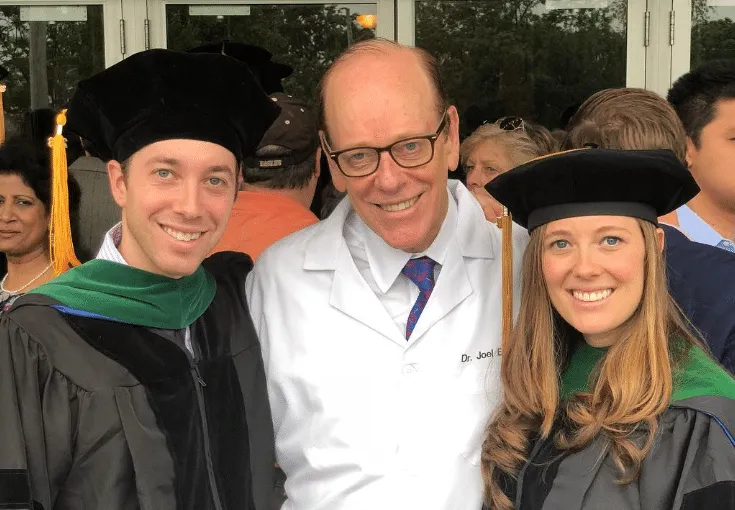When comparing stem cell hair transplant vs FUE, the main difference is that stem cell methods support existing hair and wake dormant hair follicles in early thinning, while FUE fills balding areas by moving new transplanted hair where roots no longer grow. In short, stem cell therapy improves thickness in mild cases, and follicular unit extraction (FUE) offers stronger coverage where hair no longer grows.
Hair restoration now offers more options for people who have experienced hair loss. At Kopelman Aesthetic Surgery, Dr. Kopelman helps patients understand how each method supports new growth while also protecting existing hair through regenerative medicine. Patients can also review a detailed guide on stem cell vs hair transplant to understand how both options compare.
Key Takeaways
- Stem cell therapy supports existing hair and works best for early thinning, while FUE places new follicles into balding areas.
- FUE gives more predictable density and long-lasting coverage, but nearby native hair may still thin over time.
- Stem cell therapy is minimally invasive, while FUE needs careful graft protection.
- Costs depend on clinic skill, session count, and follow-up care.
- Donor supply, areas of hair loss, and overall health guide the best choice.
Table of Contents
ToggleIs Stem Cell Hair Transplant Better Than FUE?
Stem cell therapy wakes up dormant hair follicles, while FUE moves healthy ones to thinning zones. Each option supports different stages of hair loss and may serve as a hair loss treatment when chosen correctly. Patients should compare goals, donor supply, and expected density.
There is no single answer for everyone. Early thinning responds well to regeneration, while advanced baldness often needs relocated follicles. A medical evaluation helps match patients to the right plan.
Density Output and Expected Coverage
Stem cell therapy thickens existing hair and improves texture, but does not replace lost roots. FUE adds transplanted hair into the recipient area for stronger coverage. Surgeons plan placement based on donor strength and hairline shape.
Measuring Success Across Treatment Zones
Hairlines and crown areas respond in different ways. Crowns often need more density because of swirl patterns. Staged planning supports balanced outcomes.
Key differences
Stem cell therapy may require multiple sessions to maintain progress. FUE places new follicles that improve appearance after several months. Patients should consider long-term durability and maintenance needs.
How Stem Cell Hair Transplants Work
A stem cell hair transplant uses a tissue sample processed into a growth solution. The doctor injects this solution into thinning zones to support weak follicles with added growth factor activity. The body slowly restarts healthier cycles in areas of hair loss.
Stem cells release signals that improve density and help follicles work harder. This option works best for mild to moderate thinning. Patients often report a thicker texture and stronger strands.
Scientific Foundation Behind Stem Cell Activity
Stem cells support follicles by sending signals that wake dormant hair follicles. These signals increase fullness and encourage regrowth stages. Research continues to improve consistency and safety.
Success rates
Stem cell therapy shows moderate success rates in early thinning, but results vary based on follicle activity. FUE has higher success rates because transplanted hair grows permanently in balding areas.
Before and after
Most changes are gradual, improving texture and coverage first. Results vary by scalp health and care routines. Consistent follow-up supports improvements.
Stem Cell Hair Transplant Results

FUE results

Disadvantages and risks
Stem cell treatment may not work on zones with full follicle loss. Advanced baldness may need transplanted hair. Some side effects may include swelling, redness, or temporary irritation.
How FUE Hair Transplantation Works
FUE removes donor follicles and places them into thinning areas, improving density and reshaping the hairline. Tiny marks heal with minimal scarring because this method is minimally invasive. Marks fade as recovery advances.
Surgeons tilt grafts to match the natural direction. This gives natural styling and helps blend with existing hair.
Advantages
FUE works well for moderate to advanced thinning. It can restore hairlines and rebuild bald spots. Results look natural and can last many years.
Limitations
Results depend on donor strength. Overharvesting can thin the donor region. Some patients may need more than one session for ideal coverage.
Recovery Time for Each Procedure
Most stem cell patients return to routine activities quickly. Recovery is short due to the lack of graft placement. Mild soreness can appear for a few days.
FUE recovery takes a bit longer. Grafts need protection and gentle washing. Redness and swelling may last one to two weeks.
Stem cell recovery timeline
Stem cell therapy has a short recovery time, and most patients return to normal routines within 2 to 3 days.
FUE has a longer recovery time, often taking one to two weeks for swelling to fade and grafts to stabilize.
Longevity of Results for Each Method
Stem cell results can last for years but may fade with aging or genetic shedding. FUE provides permanent follicles that resist loss. Surrounding native hair may still thin.
Pain and Anesthesia Experience
Both methods use local anesthesia to reduce discomfort. Stem cell injections may feel like short bursts of pressure. FUE extraction may feel like a gentle pull. Most patients tolerate both well.
Stem Cell Hair Transplant vs FUE Cost
Stem cell hair transplant sessions often range from $3,000 to $5,000, depending on clinic technology and treatment plans. FUE procedures typically range from $15,000 to $25,000, based on graft count and surgeon experience. Prices can vary by location, hair loss level, and follow-up needs. To learn more about pricing ranges and what factors influence them, review this resource on stem cell hair transplant cost and our breakdown of hair treatment cost.
Hidden Secondary Costs
Patients may need supportive treatment to preserve results. Medication and follow-up visits protect long-term density. Planning helps manage expectations.
Budget considerations
Financing can help patients access expert care. Skilled surgeons prevent costly revisions. Research helps avoid poor outcomes.
Stem Cell Hair Transplant vs FUE Reviews
Online reviews share comfort, speed, and visual outcomes. Many praise stem cell therapy for texture improvement. FUE reviews praise natural hairlines and thick coverage.
Reviews change based on goals and the stage of hair loss. Medical clinics offer safer supervision. Multiple opinions help guide choices.
Patient satisfaction
Many report higher confidence and more styling options. Follow-up visits lower stress. Realistic expectations guide satisfaction.
Common feedback themes
Stem cell patients like gradual thickening. FUE patients value permanent repair of balding areas. Both methods require patience for the final results.
Stem Cell Hair Transplant vs PRP
PRP uses platelet-rich plasma to support weak follicles. It works well for early thinning and can support other treatments. PRP costs less but offers moderate thickening.
Safety, Regulations, and Scientific Evidence
Stem cell treatments require medical oversight, and rules vary by region. Some clinics offer unapproved therapy. FUE has decades of proven success in hair restoration.
Potential complications
Minor swelling, redness, or temporary shedding may occur. Aftercare reduces risks and supports graft survival. Surgeons monitor healing.
Regional regulatory status
Rules differ by country. Licensed clinics follow strict guidelines. These rules protect patient safety.
Current research findings
Research shows promise in improving texture and fullness. Studies continue to test long-term results. Doctors monitor updates as regenerative medicine evolves.
Session Planning and Follow-Up Expectations
Surgeons plan sessions based on patient response and density goals. Follow-up visits check coverage and stability. Clear communication supports success.
Maintenance Considerations and Long-Term Care
Supportive therapy preserves improvements. Lifestyle habits matter. Healthy routines support better density and overall health.
Myths and Misconceptions
Stem cell therapy strengthens follicles but does not create new roots. Transplant results appear slowly. Shedding may happen before growth cycles start.
Common misunderstandings
Donor supply still matters with stem cell methods. One session rarely solves advanced thinning. Education reduces confusion.
Who Should Choose Each Option
Stem cell therapy suits early thinning with active follicles. FUE helps with bald spots and receding hairlines. Consultation guides the right choice.
Age, health, and donor supply shape outcomes. Personalized plans help match goals. Balanced planning improves results.
Who Should Avoid Certain Treatments
Scarring may limit the success of stem cell therapy. Full follicle loss may need transplanted hair. Medical instability lowers growth results.
Conditions That Limit Success
Autoimmune issues can weaken results. Hormonal imbalance may need treatment first. Severe baldness may require combined methods.
Ideal candidates
Mild thinning responds best to stem cell therapy. Good health supports recovery. Gradual improvement is normal.
Eligibility criteria
Donor density, scalp health, and hormones matter. Medical history shapes outcomes. Habits like smoking may reduce success.
Lifestyle considerations
Fast recovery makes stem cell therapy ideal for busy patients. Athletes should avoid friction after FUE. Sun exposure and helmets may affect graft survival.
Donor Management and Long-Term Planning
Donor zones must be harvested with care. Even extraction prevents visible thinning. Planning preserves future transplant options.
Technical Tools and Precision Methods
Modern technology reduces trauma and supports survival rates. Precision improves natural results. Tools continue to improve placement accuracy.
How to Select a Qualified Surgeon
Patients should check credentials, photos, and training background. A skilled surgeon designs a natural hairline. Good communication builds trust.
Future Developments in Hair Restoration
Scientists study follicle expansion and cell cloning. These may improve density without heavy extraction. Robots may speed graft placement.
What patients can expect
New solutions may help with advanced baldness. Costs may drop as methods develop. Patients should follow credible medical sources.
Visual Expectations by Region
Hairlines improve faster and are easier to notice. Crowns may take longer due to swirl patterns. Balanced planning creates natural coverage.
Density Goals Explained
Strand thickness, color, and styling affect visual density. Thicker strands need fewer grafts. Surgeons use these factors to plan sessions.
Final Recommendation for Patients
Patients should compare stem cell hair transplant vs FUE based on donor supply, scalp pattern, and expectations. Consultation helps set realistic goals. At Kopelman Aesthetic Surgery, Dr. Kopelman guides patients toward safe results with minimal scarring.
Improvement takes time and good habits. Healthy routines support long-term success. A planned, expert-guided approach builds natural confidence.
This article explained FUE vs stem cell hair transplant using a clear medical context while comparing modern techniques to traditional hair transplants. To explore which option fits your goals, schedule a consultation with a qualified surgeon who can review your case and guide you toward lasting, confident results.

























